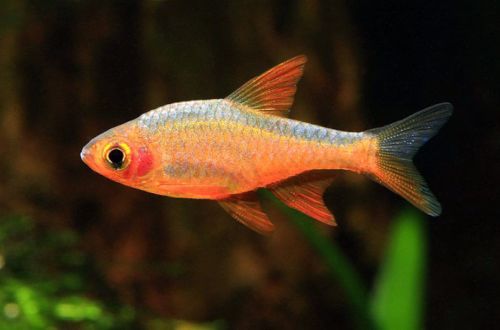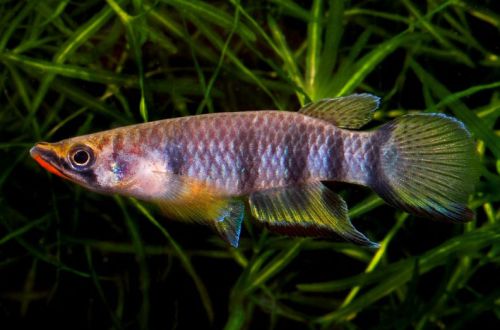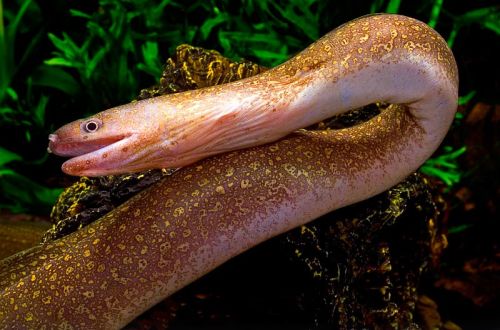
Fiery Rasbora
Fire Rasbora, scientific name Rasboroides vaterifloris, belongs to the Cyprinidae family. Beautiful but very rare fish. It lives in a tiny corner of Sri Lanka in a place where there are no predators, and water conditions practically do not change during the year. When keeping, special attention is paid to the quality of water and the careful selection of neighbors. Breeding on a commercial basis is not widespread, so it is difficult to acquire Rasbora.

Contents
Habitat
Endemic to the skeleton of Sri Lanka, its southeastern tip, the so-called “wet zone”. In this region, 2000–3000 mm falls annually. rainfall, most of it falls during the monsoon between March and August. High humidity and constant high temperature contribute to the growth of lowland tropical forests, in the canopy of which the Fire Rasbora lives in numerous streams and flowing lakes with numerous aquatic plants. The sun’s rays practically do not reach the lower tier of the forest, so the water temperature is relatively low.
Currently, the habitat is almost completely destroyed, only about 4% of the original forest area remains as of 2006. The authorities of the island are trying to preserve the unique nature of the island, but the flora and fauna have already suffered irreparable damage.
Brief information:
- The volume of the aquarium – from 60 liters.
- Temperature – 23-27°C
- Value pH — 5.5–7.0
- Water hardness – soft (1-10dGH)
- Substrate type – any
- Lighting – subdued
- Brackish water – no
- Water movement – weak current or still water
- The size of the fish is up to 4 cm.
- Meals – mostly meat
- Temperament – peaceful calm fish
- Keeping in a flock of 10 individuals
Description
Adult individuals reach only 4 cm in length, and females are noticeably larger than males, but they are inferior to them in color saturation. The predominant color is orange and red, the fins are colored in the latter, the tail is often transparent with weak pigmentation.
Food
They accept all types of food, however, to maintain the brightness of the color, meat products should be served mainly in live or frozen form. Various dry food to use as a supplement to the diet. Feed 2-3 times a day in the amount eaten in 5 minutes. All uneaten residues must be removed to avoid water contamination.
Maintenance and care, maintenance of the aquarium
The volume of the tank for a flock of fish must exceed 60 liters. The basis of the design of the aquarium consists of several floating plants, a dark soft substrate and shelters in the form of snags, roots or tree branches. Adding dried leaves that have been soaked in water so they can sink will give a more natural look. In addition, the leaves, during the decomposition process, release tannins, which color the water in a faint brown color, which is also observed in natural reservoirs, where the Fire Rasbora comes from.
The set of equipment is standard and includes a filtration and lighting system, a heater and an aerator. When selecting and placing the filter, keep in mind that fish do not respond well to the movement of water, so minimize possible internal flow.
Water conditions are characterized by a slightly acidic pH value with a low concentration of dissolved calcium and magnesium salts (parameter dGH). This species is sensitive to fluctuations in the chemical composition of water, so proper water treatment is of great importance.
Maintenance is reduced to a weekly replacement of part of the water (about 10% of the volume) with fresh, regular cleaning of the soil from organic waste and glass from plaque.
Behavior and Compatibility
Peaceful, flocking, calm species, prefers to stay in a group of 6-10 individuals, which makes them less shy. In addition, in a flock, males begin to show their best coloration, in the process of competing with each other for the attention of females.
It is recommended to keep in a species aquarium, since it can be difficult to select neighbors. It is possible to combine only with fish of a smaller size and a similar temperament, and their number should be less than Rasbor.
Breeding / breeding
Fiery Rasbora belongs to the spawning species, females scatter eggs in the water column, and males at this moment fertilize it. Parental instincts are poorly developed, immediately after spawning, the fish can eat their own caviar and fry that have appeared.
Breeding is recommended to be carried out in a separate tank – a spawning aquarium, in order to protect offspring from adult fish. The design is simple, the main attention is paid to the ground, it should consist of particles of a sufficiently large size that do not fit tightly to each other, forming voids, for example, pebbles or decorative glass beads. When the eggs sink to the bottom, most of them fall into these voids and thus become inaccessible to fish. A similar effect is also achieved when using a fine mesh, which is fixed at the bottom.
Another way to ensure the preservation of eggs is to use low-growing small-leaved plants or mosses such as Riccia floating and Javanese moss, which are planted on most of the surface of the substrate (in this case, the soil can be any). Dense thickets of plants can provide reliable shelter for eggs no worse than special soil.
The size of the spawning aquarium is usually 20-30 liters. The equipment used is an aerator, a heater and a simple sponge filter of low power to prevent accidental suction of eggs and fry. Spawning occurs in dim light, so at first there is no need for a light source.
The beginning of the mating season will be marked by the fact that the females become noticeably rounder, and the males will begin to actively show signs of attention to their chosen ones. At this point, you should prepare a separate tank and fill it with water from the general aquarium, then transplant several females and the most colorful males there. Females lay eggs in portions, so spawning is delayed for 4–5 days. The easiest way to determine its ending is by females – they will become slender.
The fish are returned. The fry will appear in 24-48 hours, and after another 3-4 days they will begin to swim freely. Feed with specialized microscopic food for juvenile aquarium fish.
Fish diseases
A balanced diet and suitable living conditions are the best guarantee against the occurrence of diseases in freshwater fish, so if the first symptoms of an illness appear (discoloration, behavior), the first thing to do is check the condition and quality of the water, if necessary, return all values to normal, and only then do treatment. Read more about symptoms and treatments in the Aquarium Fish Diseases section.





